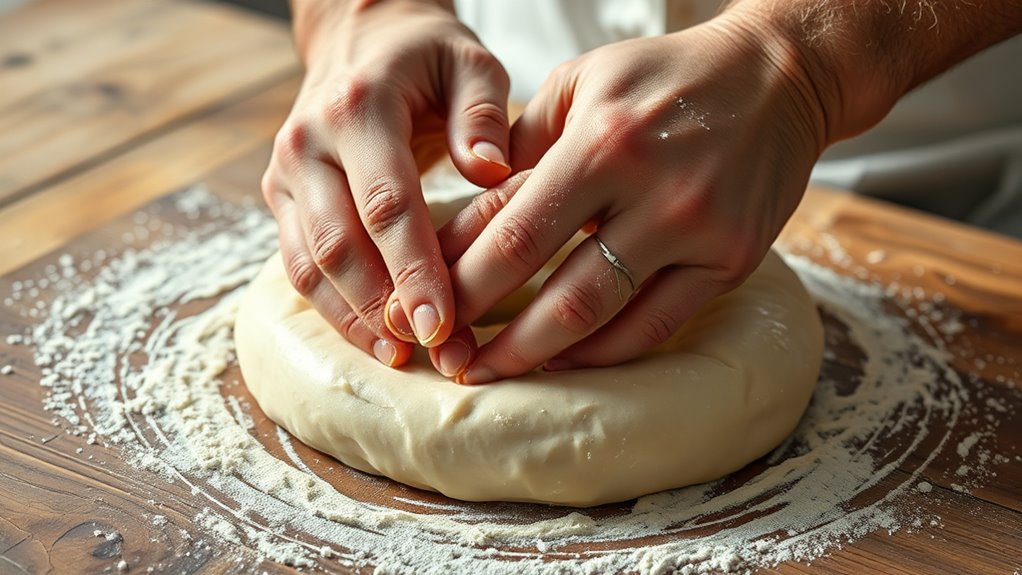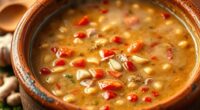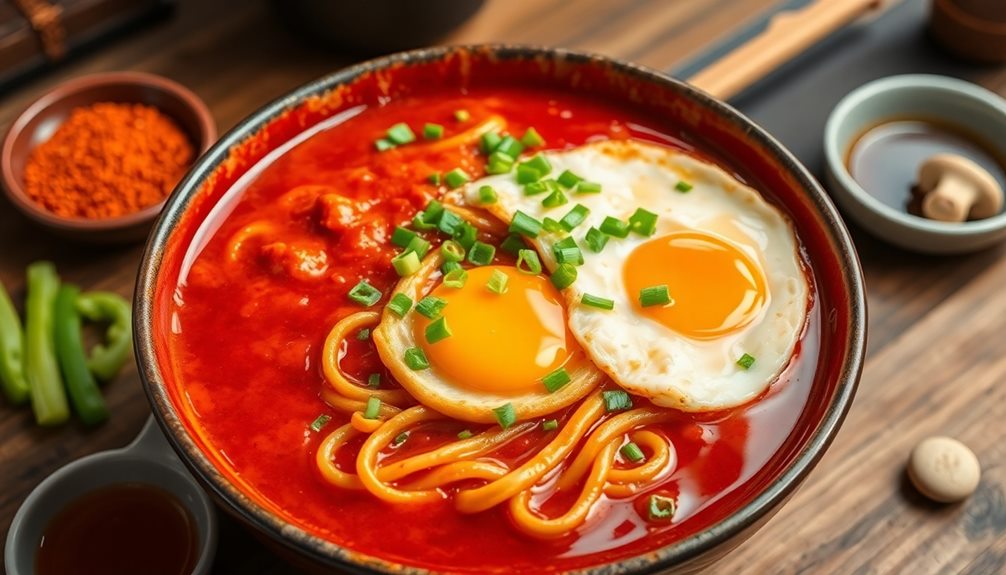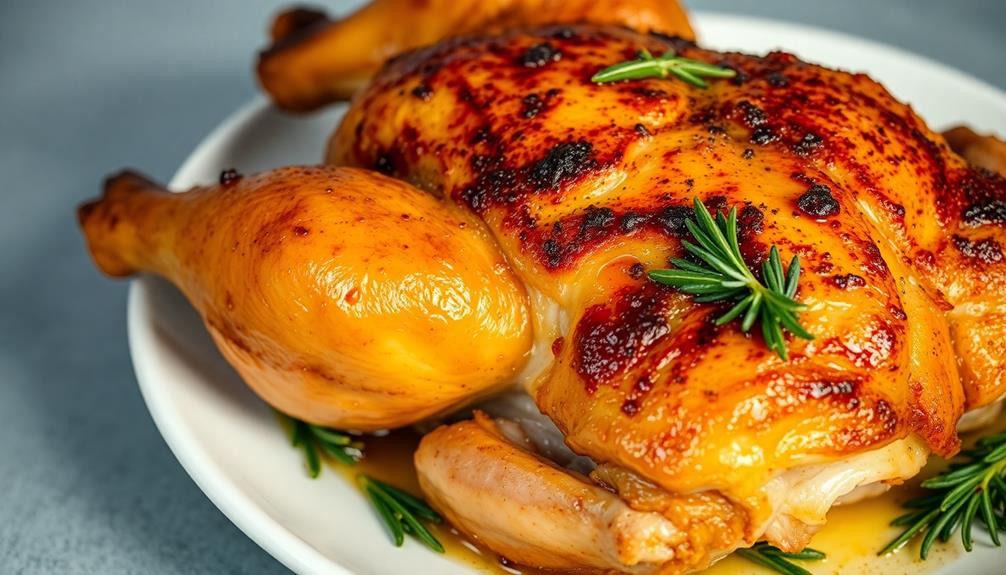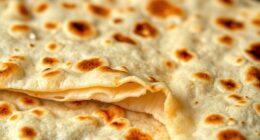When you knead dough, you’re developing gluten, a protein network that gives bread its structure. Proper kneading aligns gluten strands, making the dough elastic and able to trap gases for rise. Too little kneading results in weak gluten, leading to dense bread, while over-kneading makes it tough. The timing of kneading shapes the dough’s final texture and crumb. Keep going, and you’ll discover how to perfect your bread’s chewy, airy quality.
Key Takeaways
- Longer kneading aligns gluten proteins, forming a stronger, elastic network that results in chewier, denser bread.
- Insufficient kneading leads to weak gluten strands, producing a crumbly or flat texture.
- Over-kneading over-develops gluten, making the dough tough and less extensible.
- Proper kneading balances gluten formation with dough relaxation, optimizing elasticity and rise.
- Kneading duration influences gluten’s ability to trap gas during fermentation, affecting bread’s rise and crumb structure.

Have you ever wondered what gives bread its chewy texture and elasticity? The secret lies in gluten, a protein complex that forms when flour and water combine. When you start kneading your dough, you’re actively developing gluten strands, which dramatically influence dough elasticity. This process aligns the proteins, creating a network that traps gas bubbles produced during fermentation processes. As a result, the dough becomes stretchable, resilient, and capable of holding the rising gases that make your bread fluffy. The more you knead, the stronger and more uniform this gluten network becomes, directly impacting the final texture. But kneading isn’t just about mechanical action; it’s about encouraging the proteins to bond and form those elastic strands that give bread its characteristic chewiness. Proper gluten development is essential for achieving the ideal bread texture. Additionally, the hydration level of the dough plays a crucial role in how well the gluten network forms and develops.
Kneading develops gluten, creating a stretchable network that gives bread its chewy, elastic texture.
Fermentation processes play a vital role in this transformation. Once you’ve kneaded your dough, yeast begins feeding on the sugars, producing carbon dioxide and alcohol. The carbon dioxide gets trapped within the gluten network, causing the dough to rise. During fermentation, the gluten strands continue to develop and strengthen, making the dough more extensible and elastic. This expansion isn’t just about volume; it’s about creating a resilient structure that can support the bread’s shape and texture. The fermentation also allows enzymes to break down proteins and starches, which can further modify gluten’s properties and improve dough elasticity. The longer the fermentation, the more the gluten network matures, resulting in a chewier, more developed bread. Proper fermentation enhances gluten development and overall dough quality.
Kneading time directly influences how well this gluten network forms. Too little kneading, and the gluten strands remain weak and uneven, leading to bread that’s dense or crumbly. Too much kneading, especially with machines, can over-develop gluten, making the bread tough. Finding the right balance guarantees ideal dough elasticity, which is essential for a light, airy crumb. It’s a delicate dance between mechanical work and biological fermentation. As the dough rests and ferments, the gluten continues to relax and strengthen, contributing to a better crumb structure. That means your kneading and fermentation processes are intertwined, each shaping the final bread’s texture. Proper fermentation techniques can further influence gluten’s extensibility and the bread’s final quality.
In essence, understanding how dough elasticity develops through proper kneading and fermentation helps you craft bread with the perfect chew and rise. It’s the gluten structure, honed through these processes, that transforms simple ingredients into something satisfying and delicious. By paying attention to how you knead and allowing fermentation to work its magic, you control the bread’s texture, making every loaf uniquely your own.
Frequently Asked Questions
Can Gluten Be Harmful to People Without Gluten Intolerance?
You might wonder if gluten is harmful to people without gluten sensitivity. For most, gluten doesn’t pose health risks, but some believe it could impact overall well-being. While gluten and health are linked mainly through sensitivities and celiac disease, there’s limited evidence that gluten harms those without these issues. If you’re concerned, consult a healthcare professional. Generally, eating gluten-containing foods is safe unless you have a diagnosed sensitivity.
How Does Gluten Affect Bread Rising in Different Climates?
Did you know that climate impact can influence bread rising? In humid climates, higher moisture levels can make dough more elastic, affecting how well gluten develops. Conversely, dry climates may cause dough to become less elastic, hindering rising. You’ll notice that adjusting kneading time helps manage these effects, ensuring your bread rises perfectly regardless of climate. So, understanding gluten’s role in dough elasticity helps you bake consistently, no matter where you are.
Are There Gluten-Free Alternatives That Mimic Bread Texture?
You want gluten-free alternatives that mimic bread texture, right? Using gluten-free flours like rice, tapioca, or potato starch can help. Combining these with ingredients like xanthan gum or psyllium husk adds elasticity, giving your bread a better structure and chewiness. While it may not perfectly replicate traditional bread, experimenting with different flour blends and hydration levels can get you closer to that satisfying bread texture you crave.
Does Adding Salt Influence Gluten Development During Kneading?
In the kneading process, adding salt influences gluten development through salt interaction with proteins. Salt strengthens the gluten network by tightening the dough’s structure, resulting in better elasticity and chewiness. It also slows down enzyme activity, giving you more control over fermentation. So, when you add salt during kneading, you’re actively shaping the gluten’s strength and texture, which ultimately impacts the bread’s final crumb and crust.
How Does Gluten Structure Differ in Whole Grain Versus White Bread?
Ever wonder why whole grain bread feels denser than white bread? It’s because of their different grain compositions and milling processes. Whole grain flour retains the bran and germ, which interfere with gluten formation, resulting in a less stretchy structure. In contrast, white flour has fewer outer layers, allowing for stronger gluten networks. So, your bread’s texture directly reflects the grain’s makeup and how it’s processed.
Conclusion
So, next time you knead your bread, remember it’s not just about getting those gluten strands to stretch; it’s about wielding the mighty power to turn dough into artisan magic—or a dense, brick-like disaster. Lengthening or shortening that kneading time isn’t just a culinary whim; it’s a secret handshake with gluten itself. Embrace the chaos, experiment boldly, and perhaps—just perhaps—you’ll discover the true bread-baking prophecy hidden in every knead. Or, you know, end up with a doorstop.
